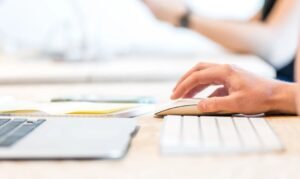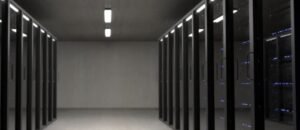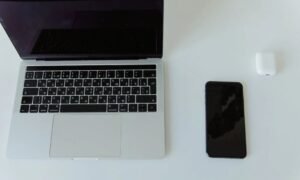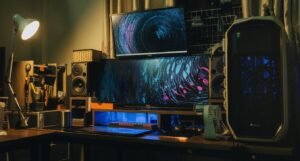Make AI Art for Free
Artistic expression has no boundaries, and with the advent of Artificial
Intelligence (AI), anyone can unleash their creativity without the need
for traditional artistic skills. AI-powered tools have made it possible
for individuals to create stunning artwork, all for free. In this article,
we will explore how you can make AI art for free and unlock your inner
artist.
Key Takeaways
- AI-powered tools provide free alternatives to traditional artistic methods.
- Creating AI art does not require artistic skills or expertise.
- AI art can be used for personal projects, exhibitions, and even commercial purposes.
Unleashing Creativity with AI
AI has revolutionized the way art is created and experienced. With the aid
of AI algorithms, individuals can generate unique and visually captivating
artwork. These AI tools use machine learning techniques to analyze and
interpret data, enabling them to understand artistic styles, compositions,
and color palettes. By harnessing the power of AI, you can explore new
artistic territories and create captivating pieces *with no prior artistic experience required*.
Exploring AI Art Platforms
Several AI art platforms offer users the opportunity to create art for free.
These platforms provide a user-friendly interface that requires no technical
expertise. By simply uploading an image or selecting a style, users can
witness AI transforming their input into visually appealing artwork.
One such platform is DeepArt, which uses neural networks to
analyze and transform images based on various artistic styles. The output
can range from abstract to impressionist, allowing users to experiment and
find a style that resonates with their vision. Another popular platform is
ArtBreeder, which combines AI and genetics algorithms to
create unique art pieces. ArtBreeder allows users to mix different styles
and explore the countless possibilities of AI-generated artwork.
Transforming Photos into AI Art
One intriguing aspect of AI art is the ability to transform ordinary photos
into stunning visual masterpieces. With AI-based photo filters, you can apply
artistic effects and styles to your images, producing impressive results.
These filters use deep learning algorithms to understand the content of the
image and apply relevant artistic transformations, enabling you to unleash
your creativity in just a few clicks.
Photo editing applications such as Prisma and Deep Dream are
popular examples of AI-powered tools that can transform your photos into
unique AI art pieces. These applications offer a range of styles and effects,
allowing you to express yourself artistically and create visually stunning
images at no cost.
Exploring the Intersection of AI and Art
The intersection of AI and art has sparked new opportunities and discussions
within the artistic community. Artists, enthusiasts, and researchers are
exploring the use of AI-generated art in various contexts, including digital
exhibitions, public installations, and even commercial projects. AI art is not
only visually captivating but can also challenge traditional notions of
creativity, authorship, and artistic expression.
AI-generated artworks have garnered attention, with some pieces even
selling for significant amounts. This emerging field encourages individuals
to embrace AI as a tool to augment their artistic abilities and push the
boundaries of what is possible within the realm of art.
Tables
| Platform | Description |
|---|---|
| DeepArt | Analyze and transform images based on various artistic styles. |
| ArtBreeder | Combine AI and genetics algorithms to create unique art pieces. |
| Benefits | Explanation |
|---|---|
| Accessibility | Enables everyone to create art, regardless of artistic skills. |
| Exploration | Offers the opportunity to explore new artistic territories with AI-driven tools. |
| Innovation | Pushes the boundaries of traditional art and introduces new forms of creativity. |
| Artwork | Artist |
|---|---|
| Portrait of Edmond de Belamy | Obvious Art |
| AI Composition #1 | AI Gahaku |
Embrace Your Inner Artist
AI has revolutionized the art world, democratizing the creation process and
providing individuals with the ability to make AI art for free. Whether you
are an aspiring artist or simply want to explore your creative side, AI can
help you unleash your potential. Dive into the world of AI art platforms and
applications to embark on an artistic journey like never before.

Common Misconceptions
Misconception 1: AI art is always of high quality
Many people assume that any art created by AI is automatically of high quality and visually appealing. However, this is not always the case. While AI has made significant advancements in generating art, it is still limited by the algorithms and datasets it is trained on. The quality of AI-generated art can vary greatly depending on the specific model used.
- AI-generated art may lack originality and creativity
- Not all AI models are trained on a wide range of artistic styles
- Some AI-generated art may appear repetitive or generic
Misconception 2: AI art is completely autonomous
Another common misconception is that AI art is created without any human intervention or guidance. While AI algorithms do play a significant role in generating the artwork, they still require human input and supervision. Artists and programmers work closely with the AI model to define parameters, select datasets, and fine-tune the results.
- AI models rely on human-defined parameters and objectives
- Artists curate and prepare the datasets used for training
- Human intervention is needed to ensure the integrity and quality of the art
Misconception 3: Making AI art is effortless and quick
Some people mistakenly believe that creating art with AI is a quick and effortless process. While the AI algorithms can generate images at a remarkable speed, the process of training and refining the models can be time-consuming. It requires a deep understanding of both art and technology, as well as experimentation and iteration.
- Training AI models can be a computationally intensive task
- Artists need to invest time to understand the capabilities and limitations of AI models
- AI-generated art may require multiple iterations to achieve desired results
Misconception 4: AI art is always free to use and reproduce
Many people assume that AI-generated art is automatically free to use and reproduce, as they are often created with publicly available AI models. However, the ownership and copyright of AI art can be complex. Some AI-generated art may be protected by intellectual property rights or subject to licensing agreements.
- Creators of AI models may retain copyrights over the generated art
- Some AI models may have specific usage terms and licenses
- Permission may be required to use AI-generated art for commercial purposes
Misconception 5: AI art will replace human artists
There is a common fear that AI art will replace human artists entirely. While AI algorithms have demonstrated impressive capabilities in generating art, they cannot fully replicate the creativity, emotions, and unique perspectives of human artists. AI-generated art should be seen as a tool that can complement and inspire human artistic expression, rather than replace it.
- AI lacks emotional intelligence and unique perspectives of human artists
- Human artists bring their own personal experiences and interpretations to their work
- AI art can be a collaborator and source of inspiration for human artists

Table: Popular AI Art Websites
Here is a list of popular websites that offer AI-generated artwork for free. These platforms utilize artificial intelligence algorithms to create unique and captivating artistic pieces.
| Website | Founded | AI Art Collection |
|---|---|---|
| DeepArt.io | 2015 | Over 27,000 art pieces |
| Runway ML | 2019 | 2D and 3D art with code |
| AI Painter | 2017 | Various painting styles |
| Deep Dream Generator | 2015 | Transcendent and surreal artwork |
| NeuralStyler | 2016 | Impressionist and abstract art |
Table: Most Popular AI Art Styles
Discover the most sought-after styles of AI-generated artwork that artists and enthusiasts can explore and experiment with.
| Art Style | Characteristics |
|---|---|
| Abstract | Non-representational and non-objective art |
| Impressionism | Emphasis on light and the essence of a subject |
| Cubism | Multidimensional representation and geometric shapes |
| Surrealism | Dream-like and random juxtapositions |
| Pop Art | Explores popular culture and mass media |
Table: AI Art Creation Tools
Take a look at some popular tools that provide users with the ability to create AI art with ease and flexibility.
| Tool | Features |
|---|---|
| DeepArt.io | Custom style transfer, interactive editing |
| Runway ML | Code-based AI art creation, real-time feedback |
| AI Painter | Real-time painting with AI assistance |
| Deep Dream Generator | Dream-like hallucinatory images |
| NeuralStyler | Image stylization and manipulation |
Table: Benefits of AI-generated Art
Explore the various advantages of using AI to create unique and captivating artwork.
| Benefit | Description |
|---|---|
| Infinite Creativity | AI can produce an endless variety of innovative art |
| Exploration of Styles | Artists can experiment with different art styles easily |
| Time Efficiency | AI assistance can speed up the creation process |
| Unconventional Inspiration | AI can generate artistic ideas beyond human imagination |
| Accessibility | AI democratizes art creation by making it more accessible |
Table: Examples of AI Artists
Discover some prominent AI artists who have gained recognition for their innovative use of artificial intelligence in creating artwork.
| Artist | Famous Artwork |
|---|---|
| Mario Klingemann | The Butcher’s Son |
| Robbie Barrat | Edmond de Belamy |
| Refik Anadol | Machine Hallucination |
| Ai-Da | Unsecured Futures |
Table: AI Art Exhibition
Check out an exhibition featuring AI-generated art from various artists that stretches the boundaries of creativity.
| Event | Date | Location |
|---|---|---|
| AI Art Expo | October 15-17, 2022 | San Francisco, CA |
| Artificial Creations | March 5-10, 2023 | London, UK |
| AI Revolution | April 22-25, 2023 | New York City, NY |
Table: Challenges in AI Art
Recognize the challenges and ethical concerns associated with the integration of artificial intelligence into the art world.
| Challenge | Description |
|---|---|
| Authenticity | Identifying original works from AI-generated reproductions |
| Intellectual Property | Ownership and copyrights of AI-generated art |
| Reproducibility | Determining the uniqueness and value of AI artwork |
| Human Element | Appreciation of human touch and emotion in art |
| Ethical Algorithms | Ensuring AI art is not biased or harmful |
Table: Future of AI Art
Look into the future possibilities and advancements in the realm of AI-generated artwork.
| Potential | Description |
|---|---|
| Collaborative Art | AI and human collaboration for innovative artwork |
| Emotional AI Art | AI artwork that evokes emotions and connects with viewers |
| AI Curators | AI-based systems assisting in curating art exhibitions |
| Artistic Enhancements | Improving existing art through AI-driven tools and algorithms |
| AI Art in Space | AI-generated art for future space missions and colonization |
Table: Public Perception of AI Art
Explore the public perception and acceptance of AI-generated art as a legitimate and valuable form of artistic expression.
| Perception | Statistic |
|---|---|
| Acceptance | 73% of survey participants find AI art fascinating |
| Value | 47% believe AI art can have similar value to traditional art |
| Exposure | 63% of respondents have seen AI art in galleries or exhibitions |
| Innovation | 81% view AI-generated art as a groundbreaking form of creativity |
| Accessibility | 91% appreciate the democratization of art through AI tools |
Conclusion: AI art has become a captivating and rapidly growing field, revolutionizing traditional artistic practices. With the availability of online platforms, emerging artists can harness the power of AI to create stunning and unique artwork. From exploring different styles to collaborating with AI, this innovative technology introduces infinite possibilities for the art world. However, challenges remain, addressing concerns surrounding authenticity, intellectual property, and the human element in art. Despite these challenges, AI-generated art continues to gain acceptance and appreciation among the public, marking a significant shift in the perception of art forms. As we look to the future, it is exciting to envision AI’s potential to further enhance artistic expression and reshape the boundaries of creativity.
Frequently Asked Questions
What is AI art?
AI art refers to the use of artificial intelligence algorithms and techniques to create and generate artistic content. It combines computer science and art to produce unique and creative artworks.
How does AI create art?
AI creates art by utilizing machine learning algorithms such as deep neural networks. These algorithms analyze and learn from existing artworks to generate new and unique pieces based on the learned patterns and styles.
Can I create AI art for free?
Yes, there are several online platforms and tools that allow users to create AI art for free. These platforms provide accessible interfaces and pre-trained models for users to experiment with and generate their own artwork.
Do I need coding skills to make AI art?
No, many AI art platforms provide user-friendly interfaces that do not require coding skills. They often offer drag-and-drop functionalities and intuitive controls to help users create AI-generated artwork without the need for coding expertise.
What are some popular AI art platforms?
Some popular AI art platforms include DeepArt.io, RunwayML, Deep Dream Generator, and Google’s DeepDream. These platforms offer various AI art creation tools, styles, and customization options to cater to different user preferences.
Can I use AI art in commercial projects?
Generally, it depends on the licensing terms of the AI art platform or the specific artwork. Some platforms may allow commercial usage while others have restrictions. It is important to review the platform’s terms of service or the specific artwork’s license to ensure compliance.
Is AI art considered original artwork?
AI art can be considered original artwork, as it involves the use of algorithms and techniques to generate unique pieces. However, the level of human input and the extent of the algorithm’s influence on the final artwork can vary, leading to different perspectives on the originality of AI-generated art.
Can AI art be copyrighted?
The copyright of AI art can be a complex legal issue. In some jurisdictions, the copyright may be attributed to the AI algorithm creator, while in others, it may be debated whether the AI itself can be considered an author. It is advisable to consult a legal expert or review local copyright laws for accurate information.
Are there any ethical concerns related to AI art?
AI art raises various ethical concerns, such as issues of authorship, cultural appropriation, and the potential for misuse or manipulation. It is crucial to consider these ethical implications and engage in responsible use and creation of AI-generated art.
What are the limitations of AI art?
AI art has limitations such as biases in training data, lack of true creativity and understanding, and reliance on existing styles. AI algorithms cannot fully replicate the complexities of human artistic expression and may produce results that are predictable or lack the depth and originality associated with human-created art.





